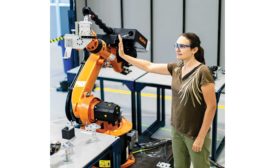Home » Keywords: » vision robotics
Items Tagged with 'vision robotics'
ARTICLES
Quality in Automation > Robotics 101
Vision guided robotics today encompasses all the technologies needed to recognize, process and handle objects based upon visual data.
Read More
Vision Robotics Takes Off
Machine vision and robots continue to solve problems on the factory floor.
May 8, 2019
The Resurgence of Vision Guided Robotics
Manufacturers that have dismissed the use of robotics in the past are now taking a fresh look due to advancements in machine vision technology.
July 1, 2018
Get our new eMagazine delivered to your inbox every month.
Stay in the know with Quality’s comprehensive coverage of the manufacturing and metrology industries.
SIGN UP TODAY!Copyright ©2024. All Rights Reserved BNP Media.
Design, CMS, Hosting & Web Development :: ePublishing




